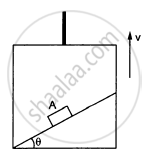Advertisements
Advertisements
प्रश्न
The motion of a particle of mass m is given by x = 0 for t < 0 s, x(t) = A sin 4 pt for 0 < t < (1/4) s (A > o), and x = 0 for t > (1/4) s. Which of the following statements is true?
- The force at t = (1/8) s on the particle is – 16π2 Am.
- The particle is acted upon by on impulse of magnitude 4π2 A m at t = 0 s and t = (1/4) s.
- The particle is not acted upon by any force.
- The particle is not acted upon by a constant force.
- There is no impulse acting on the particle.
उत्तर
a, b and d
Explanation:
Given, `x = 0` for `t < 0 s`.
`x(t) = A sin 4pit`; for `0 < t < 1/4 s`
`x = 0`; for `t > 1/4 s`
For, `0 < t < 1/4 s`
`v(t) = (dx)/(dt) = 4π A cos 4πt`
`a(t)` = acceleration
= `(dv(t))/(dt)`
= – 16π2 A sin 4 πt
At `t = 1/8 s, a(t) = - 16 π^2 A sin 4π xx 1/8 = - 16π^2 A`
`F = ma (t) = - 16 π^2` A × m = `- 16 π^2` mA
Impulse = Change in linear momentum
= `F xx t = (- 16 π^2 Am) xx 1/4`
= `- 4π^2 Am`
The impulse (Change in linear momentum) at t = 0 is the same as, t = `1/4 s`.
Clearly, force depends upon A which is not constant. Hence, force is also not constant.
APPEARS IN
संबंधित प्रश्न
A helicopter of mass 1000 kg rises with a vertical acceleration of 15 m s–2. The crew and the passengers weigh 300 kg. Give the magnitude and direction of the
(a) force on the floor by the crew and passengers,
(b) action of the rotor of the helicopter on the surrounding air,
(c) force on the helicopter due to the surrounding air.
In a TV picture tube, electrons are ejected from the cathode with negligible speed and they attain a velocity of 5 × 106 m/s in travelling one centimetre. Assuming straight-line motion, find the constant force exerted on the electrons. The mass of an electron is 9.1 × 10−31 kg.
Both the springs shown in the following figure are unstretched. If the block is displaced by a distance x and released, what will be the initial acceleration?

An empty plastic box of mass m is found to accelerate up at the rate of g/6 when placed deep inside water. How much sand should be put inside the box so that it may accelerate down at the rate of g/6?
A block A can slide on a frictionless incline of angle θ and length l, kept inside an elevator going up with uniform velocity v in the following figure. Find the time taken by the block to slide down the length of the incline if it is released from the top of the incline.

Two balls A and B of masses m and 2 m are in motion with velocities 2v and v, respectively. Compare:
(i) Their inertia.
(ii) Their momentum.
(iii) The force needed to stop them in the same time.
Calculate the magnitude of force which when applied on a body of mass 0.5 kg produces an acceleration of 5 m s-2.
Why is it advantageous to turn before taking a long jump?
What do you mean by linear momentum of a body? A force causes an acceleration of 10 ms-2 in a body of mass 1 kg. What acceleration will be caused by the same force in a body of mass 4 kg?
A hockey player is moving northward and suddenly turns westward with the same speed to avoid an opponent. The force that acts on the player is ______.
